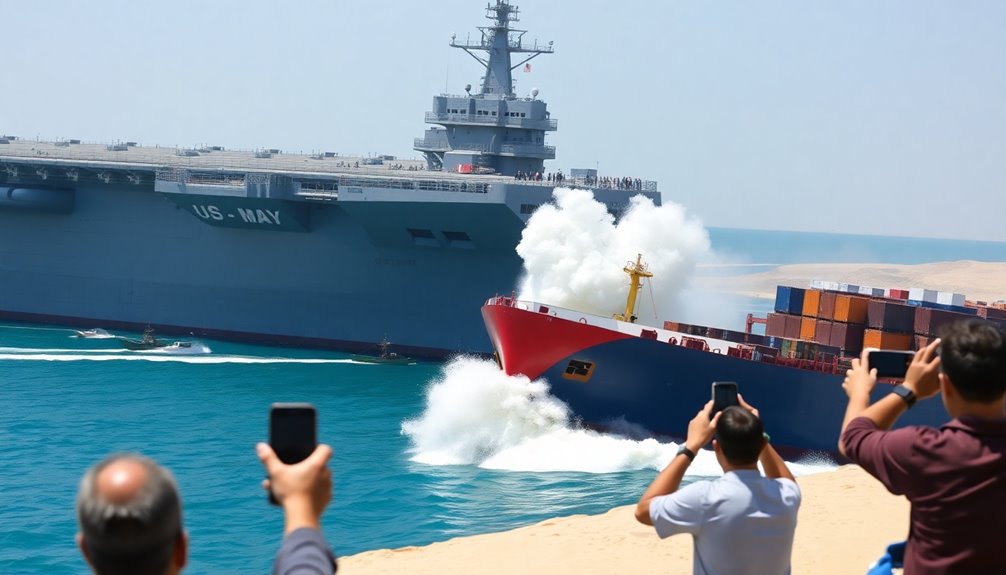On February 12, 2025, the USS Harry S. Truman collided with the Panamanian-flagged bulk carrier Besiktas-M in the Suez Canal. The incident occurred at night when around 100 ships were navigating the busy route. Fortunately, no injuries or flooding were reported on either vessel. While Truman sustained damage above the waterline, it remained operational. This collision raises concerns about safety in crowded waters and the implications for naval presence in the region. There's more to uncover about the aftermath and investigation.
Key Takeaways
- The USS Harry S. Truman collided with the Panamanian-flagged bulk carrier Besiktas-M near Port Said, Egypt, on February 12, 2025.
- No injuries or flooding were reported on either vessel, and Truman's propulsion systems remained operational despite damage above the waterline.
- The incident occurred in a crowded Suez Canal area, highlighting navigation challenges in restricted waters with around 100 ships present.
- This collision is significant, marking the third absence of a US aircraft carrier in Middle Eastern waters within 15 months.
- The US Navy is investigating the incident, raising concerns about maritime safety protocols in crowded and strategically important waterways.

Late on February 12, 2025, the USS Harry S. Truman, a massive Nimitz-class aircraft carrier, collided with the Besiktas-M, a Panamanian-flagged bulk carrier, near Port Said, Egypt, at the entrance to the Suez Canal. The incident occurred at approximately 11:46 p.m. local time, amidst a crowded maritime environment where around 100 ships were navigating the area.
Fortunately, no injuries or flooding were reported on either vessel, although the Truman sustained some damage above the waterline. Importantly, its propulsion systems remained unaffected, allowing it to maintain operational capability and ensuring that the carrier's propulsion plants were stable.
The USS Harry S. Truman, measuring 1,100 feet in length and crewed by about 5,000 sailors, had recently completed operations in the Red Sea, focusing on combat missions against Houthi rebels in Yemen. Prior to the collision, the carrier had made a port visit in Souda Bay, Greece, reinforcing its strategic presence in the region.
The Suez Canal is crucial for global trade, with 12% to 15% of all trade passing through it daily. The US Navy's presence in this vital waterway ensures rapid response capabilities in the Gulf region.
As the incident is now under investigation by the US Navy, the collision has raised concerns regarding navigation challenges in the restricted waters of the Suez Canal. This area's limited maneuverability increases the risk of maritime accidents, especially with larger vessels like the Truman involved.
Additionally, this event marks the third time in 15 months that Middle Eastern waters have been without a US aircraft carrier, potentially impacting regional security dynamics.
The aftermath of the collision leaves the Besiktas-M anchored near Port Said while investigations continue. The historical rarity of collisions involving US aircraft carriers, with the last notable incident dating back to 2004, adds to the significance of this event in maritime history.
Frequently Asked Questions
What Are the Potential Environmental Impacts of the Collision?
When a collision occurs in busy maritime areas, you should consider several potential environmental impacts.
Fuel spills can lead to significant damage, affecting marine habitats and biodiversity.
If the vessels carry chemicals, there's a risk of contamination that could disrupt local ecosystems.
Although immediate effects mightn't be evident, long-term repercussions depend on cleanup efforts and regulatory responses.
You'll want to monitor investigations closely to understand the full environmental implications.
How Does the Suez Canal's Navigation System Work?
Navigating the Suez Canal is like dancing on a tightrope, where precision and caution are your best allies.
You must follow the International Regulations for Preventing Collisions at Sea, and a pilot's guidance is crucial for safe passage.
Before entering, you'll contact the Suez Canal Harbour Office, ensuring your vessel's equipped with AIS and radar.
Amidst the maze of ships, you'll rely on real-time data to steer through the bustling waterway seamlessly.
What Safety Measures Are in Place for Vessels in the Suez Canal?
When navigating the Suez Canal, you'll find a range of safety measures in place.
Vessels must maintain visible loadlines and comply with specific speed limits. You'll be required to have a pilot onboard and follow emergency procedures, including using designated signals.
Continuous radar monitoring and CCTV enhance security, while tug escorts are mandatory for certain vessels.
Keeping adequate distances between vessels is crucial for safe transit, ensuring everyone's safety.
What Are the Legal Consequences of a Collision in International Waters?
When a collision occurs in international waters, you face various legal consequences.
Jurisdiction typically falls under UNCLOS or IMO guidelines. Investigations determine fault, which is crucial for liability claims. If a vessel violates navigation rules, it must prove that the violation didn't contribute to the collision.
You might pursue compensation for damages, and legal proceedings can occur in federal courts or international tribunals, depending on the specifics of the incident.
How Often Do Accidents Occur in the Suez Canal?
Accidents in the Suez Canal happen more frequently than you might think.
Between 2010 and 2019, there were 75 reported incidents, with collisions and groundings being the most common. Container ships were involved in over a third of these accidents.
Despite this, the canal maintains a good safety record, with approximately 19,000 ships passing through annually.
Conclusion
In the wake of the Suez Canal collision, it's clear that even the mightiest vessels aren't immune to chaos. The once-smooth waters, now marked by the scars of this incident, remind us of the delicate dance between commerce and military power. As ships navigate these busy channels, we're left hoping for calmer seas and clearer paths ahead. Let's remember that in this vast ocean of opportunity, a single misstep can ripple into a tidal wave of consequences.









